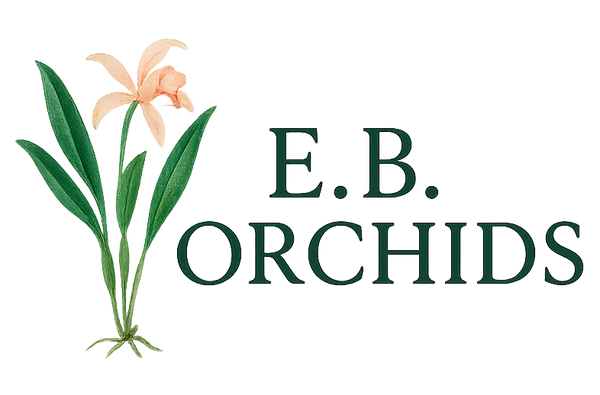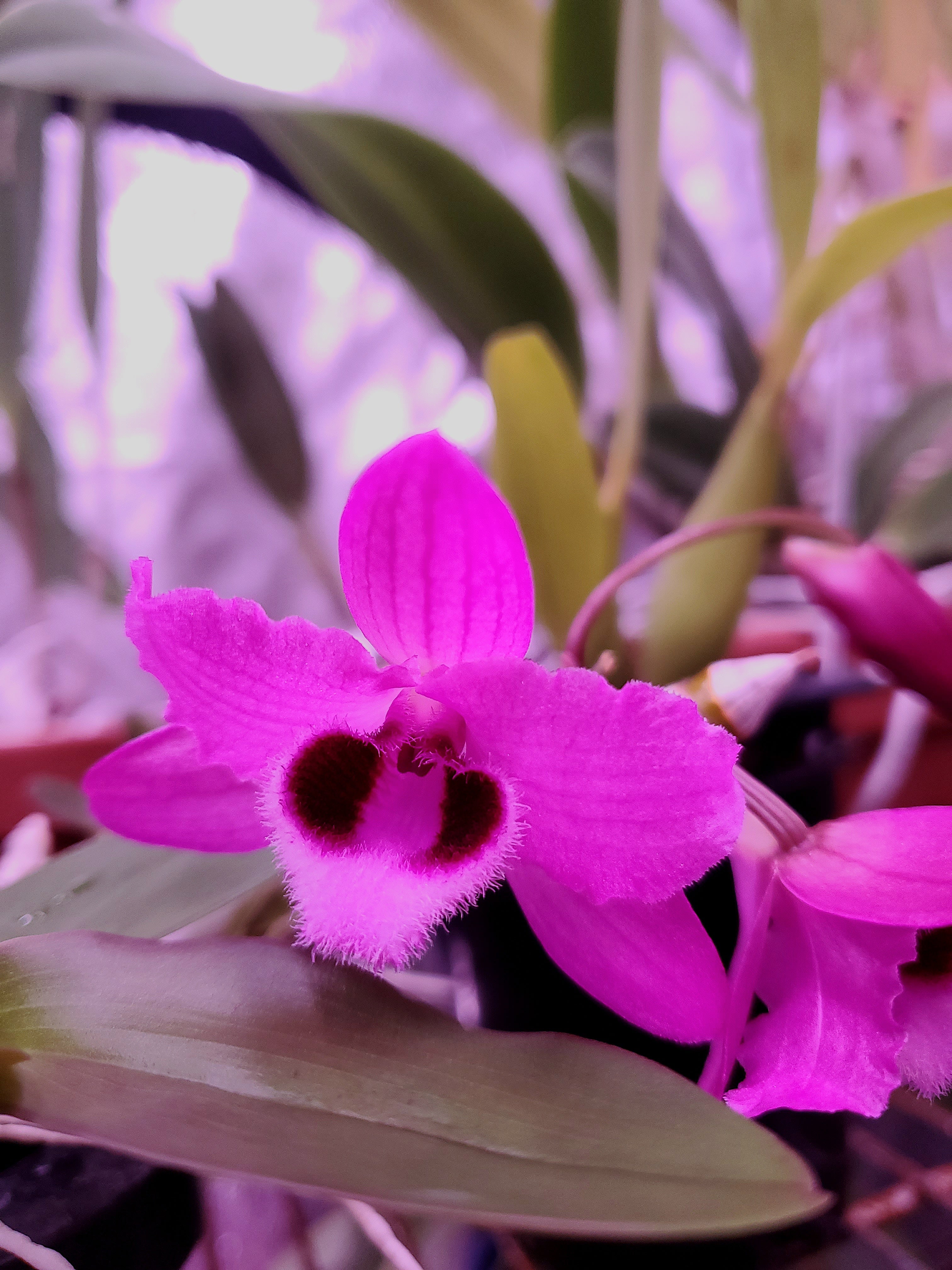Pronounciation: den-DRO-bee-um
Scroll down to read about each type of Dendrobium.
Nobile Type
Pronunciation: no-beel
This guide covers the Nobile type Dendrobium species. Nobile Dendrobiums are characterized by their club-shaped canes with deciduous leaves (meaning they fall off during the dry season). They have very distinct dry seasons and will often flower from bare canes.
-
Light
Nobile type Dendrobium should be grown in bright light with some shade (30-40%), careful to not expose them to direct sunlight as the leaves will sunburn. In the fall and winter, they should receive more light, as much as possible without direct sun. If keeping indoors, position them in a South-facing window.
-
Temperature
In the summer, keep Nobile Dendrobium warm to hot. The main distinction with this type of Dendrobium is their winter care. It's important for flowering that the plants be exposed to cold night-time temperatures during fall and winter months; some plants are tolerant of temps as low as 38F-40F, if kept dry. Blooming typically occurs in late winter or early spring. The blooms also last longer if the plants are kept cooler and drier. Temperatures can be increased when blooms fade or drop and new growth begins.
-
Water
Water and fertilize heavily in the growing seasons, especially when temperatures are high and light is strong. Most plants can be watered every day. When growths mature and fall approaches, gradually reduce watering and discontinue fertilizing (typically by mid-August). Continue a reduced watering schedule throughout the winter, only watering enough to keep the canes from shriveling - about once per week. Keep the plants dry if temperatures are below 50F to prevent rot.
An important note is that these are deciduous orchids, they will drop their leaves during the fall and winter. The leaves will yellow and eventually fall off to leave bare canes. Do not cut these canes off the plant, they are very much alive and they will be the parts of the plant that produce flowers. Note that some green foliage may remain and flowers can bud from canes that are not totally bare too. Only remove canes that are brown and dried up.
Never use ice to water orchids!
-
Humidity
Plants will greatly benefit from high humidity (>65%). In the home, as long as the plant is well watered (in summer), low humidity will not be an important factor for good growth. A humidifier can be used to increase humidity.
-
Fertilizing
Fertilize and water regularly in the growing seasons. A low nitrogen formula (i.e. 5-10-10) used at 1/4 to 1/2 strength is recommended, but should be stopped completely in winter. When night temperatures start to increase again (above 50F) start to gradually increase fertilizer. A time-released formula may be used during the growing season.
-
Repotting
Nobile Dendrobiums like to be pot-bound and will grow well in small pots. The should be potted in well draining media such as bark mixes, and also do very well mounted (typically anything a cattleya is potted in is also recommended for Dendrobium). If potted in moss, use an unglazed clay pot to help wick away extra moisture. Use plastic pots for bark and porous media. Pot the plants tightly, they may look "top-heavy" but they do not do well over-potted.
Repot when plants start to climb out of the pot, or when media starts to degrade - typically every 2 to 3 years.
Dendrobium will respond best to repotting when new growth starts.
Always use a sterile cutting tool when cutting any plant parts.
Latouria Type
Pronunciation: lah-TOOR-ee-ah
This guide covers the Latouria type Dendrobiums, which are characterized by somewhat stiff leaves that are present only at the top of the canes. They will flower from the top of the canes with typically long-lasting flowers. They hail from the Australasia region.
-
Light
Latouria type Dendrobium should be grown in bright, indirect light. In the home, they can be grown in a South window with a sheer curtain. Avoid direct sunlight, especially afternoon sun.
-
Temperature
These Dendrobium grow in a wide range of temperatures, from cool to hot depending on the species. Most common varieties do well with day temps up to 85F and night temps down to 60F. They do not require a "winter rest" like Nobile Dendrobiums.
-
Water
Watering is kept consistent throughout the year. They should be watered just as the media approaches dryness, they do not tolerate complete drying very well. Watering may be slightly reduced during winter time as growth slows or stops.
Never use ice to water orchids!
-
Humidity
These Dendrobium will appreciate relative humidity between 60% and 80%, as long as good airflow is also maintained. However, humidity is not a very important factor to growing them well.
-
Fertilizing
Fertilize and water regularly throughout the year. A regular strength, balanced formula (i.e. 10-10-10) used at 1/4 to 1/2 strength is suitable. Fertilizing can be reduced in winter, but it is not necessary.
-
Repotting
Grow in well-draining bark mixes or in sphagnum moss. If using moss, watering frequency should be reduced somewhat to avoid too much moisture retention. Latouria Dendrobium, like other Dendrobium, also like to be under-potted and root bound. Repot when plants start to "climb out" or media starts to degrade, typically every 2 years. Wait to repot until new growth starts, as new roots only emerge with new growth.
Always use a sterile cutting tool when cutting any plant parts.
Phalaenopsis/Spatulata Type
Pronunciation: fail-uh-NOP-sis or
spat-oo-lah-tuh
This section will cover the Phalaenopsis type and Spatulata type Dendrobiums.
Phalaenopsis type Dendrobiums are recognized by their flowers that closely resemble phalaenopsis flowers (but they are not related to phalaenopsis orchids).
Spatulata type Dendrobiums are also called "antelope" orchids due to the antler-like petals on their flowers. These two types of Dendrobiums require similar care.
-
Light
These Dendrobium grow best under bright, indirect light. In the home, a South window with a sheer curtain will suit them well. They can also tolerate short exposure to morning sunlight, but prolonged exposure and afternoon sun should be avoided.
-
Temperature
These Dendrobium do well in a warm to hot environment, between 65-85F year-round. They are typically not very cold tolerant and should not be exposed to temperatures below 60F.
-
Water
Water plants regularly, allowing them to nearly dry out before watering again during active growth. These are vigorous growing plants and will not tolerate prolonged periods of dryness. Typically, they do not need a reduction in water during winter, but be careful to not overwater when the plants are not in active growth. A good trick is to weight the plant on a scale (a kitchen scale works) just after watering. Weigh the plant each day and observe when the weight plateaus. Water when the weight is no longer decreasing, this can help prevent over-watering especially as the plants slow down growth.
Never use ice to water orchids!
-
Humidity
These Dendrobium will do well with humidity above 50% accompanied by good airflow. However, high humidity is not a very important factor to good growth if the plants are well watered.
-
Fertilizing
This section Dendrobium are heavy feeders, apply a regular strength, balanced fertilizer (i.e. 10-10-10) at 1/4 to 1/2 strength listed on the package up to twice weekly. Reduce fertilizer in the winter once the pseudobulbs/canes have reached maturity and resume when new growth starts.
-
Repotting
Pot in medium to large bark, or use sphagnum moss in a well draining container. Clay pots are a good option as they wick away extra moisture, but are also heavy and prevent the top-heavy plants from falling over. Like other Dendrobiums, this section also likes to be under-potted. It is best to wait to repot them until active growth just starts.
Always use a sterile cutting tool when cutting any plant parts.

